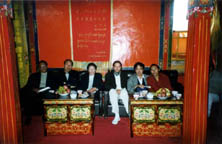 |
The Lhasa Old City Protection Working Group (LOCPWG) has taken up the tasks assigned to it in 1998. THF and Lhasa Cultural Relics Office are co-chairing the Working Group, and carry out some projects independently and some jointly under this umbrella. Cultural Relics have worked on four sites, while THF carried out work on more than a dozen sites in Lhasa, ranging from total rehabilitation to emergency repairs and water and sanitation improvement. The World Heritage List nomination of the Jokhang Temple has increased the interest of China's National Cultural Relics Ministry in the old part of Lhasa, and funding for the old city has now been made available from Beijing. THF is increasingly establishing cooperation with the relevant departments in Beijing. Still, a lot of work remains to be done. Conflicting interests, disinterest, lack of qualified local restorers are but some of the problems. Lhasa, with 400,000 people and still expanding, suffers from insufficient infrastructure to cope with the rapid growth. New high-rise construction eclipses the historic sites.
A number of sites in Lhasa are still not under official protection, and
THF has made that a priority for the coming year. At the Mandala-shaped
Jebumgang temple, for instance, which is not officially protected,
permission was given to add a modern second floor with shiny blue glass
windows. A shrine on the eastern side of the Barkor, the Palden Lhamo
Tsatsa shrine, described already by the Fifth Dalai Lama in the 17th
century as being of unknown age, is allowed to decay with a caved-in roof
because it is unprotected.